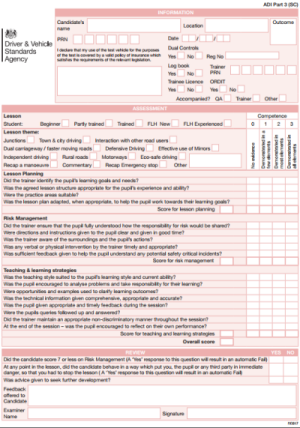 Introduction
Introduction
This section considers some aspects of your Part-Three test lesson. On this page you will find information about the test and links to videos about important aspects of the test.
Attending the appointment
When you go for your Part-Three test you will need to take a customer or friend with you for the purposes of the lesson (the driver). You cannot an ADI, nor can you take an ADI student who has passed the second part of the qualifying examination.
Your driver can be a provisional licence holder, full licence holder or an ADI student who has not yet taken the second part of their examination. There is no role-play option for Part-Three – you must have a driver with you.
You can also have an observer in the car – for example, your trainer – but as with sitting in on a driving test, they cannot take any part in the proceedings.
There is no restriction on the type of lesson you can teach, this could range from training for an absolute beginner to an advanced driving lesson. The examiner's report form has a list of lesson lesson themes but you are not bound by these and can teach any aspect of driving.
Click here for full DVSA information about the test.
During the check
We suggest that you take your driver (customer) in to the test centre to meet the examiner.
The reason for this is that if they are left outside to wait in the car 10 minutes can feel like an absolute age… For a learner driver this could be quite nerve wracking in itself leaving you with a less than ideal customer to start the lesson with.
When you take the customer in with you, you can introduce them to the examiner who will probably suggest that they go out and wait in the car while you have a brief chat. By doing this they won't have to wait as long and the examiner is no longer an unknown quantity - they have seen that he or she is a friendly human being. Consequently is less likely that they will be a gibbering wreck when you start the lesson.
The examiner will ask you for some background information about your customer, for example, if they are doing the lesson as part of a course, how many lessons they've had, what you've been working on recently. If the lesson is a one-off give a little background about the customer and why they are doing the lesson with you. Briefly explain what the lesson will be about.
Some instructors for Standards Check and ADI Part-Three students print out a brief overview with details about the customer and the proposed lesson. If you choose to do this keep it brief – a maximum of one A4 sheet with 14pt type split into small chunk paragraphs to make it a quick and easy read. Be aware that some examiners might not read your notes (this is nothing personal, simply time management).
If you are teaching the customer as part of a course, it's also good practice to have their record notes and offer these for appraisal – again the examiner might decline.
You must demonstrate clearly to the examiner that the needs that you identify as being relevant for the lesson have been discussed and agreed with the customer. The examiner will then ask you to deliver a lesson in exactly the same way as you would normally do. You will then go out to the car and deliver the lesson with the examiner in the back of the car.
The assessment
The examiner will remain quiet during the test, however you can talk to him/her if you wish, for example brief explanations like "We are going around the block again because...." - although in the general course of most tests this should not be necessary as your 'job sharing' information and explanations to the learner will fully inform the examiner.
At the end of the lesson the examiner will go back into the test centre to consider his/her notes and fill out the report form (SC1). You will then be invited in for your debrief and result.
For candidates who are unsuccessful DVSA advise examiners that:
"The purpose of feedback is to help the PDI understand where they failed to demonstrate full competence and where they need to focus their efforts when undertaking further development. They must understand what has led to the grade they have been awarded.
With the ADI Part 3/SC form you will be able to show the PDI the ‘profile' of their performance, against the individual competences, very clearly. This should help them to see where they have given a strong performance as well as where they need development."
With the above in mind the examiner's feedback, while brief, should be reasonably comprehensive. If you have an questions you should ask then then and there while the facts relating to the test are fresh in the examiner's mind.
See the assessment report form for the pass/fail marking criteria.
Use the links on this page to access each individual subject or the 'previous-next' links to go through the videos in turn.
Page menu for this section
Next: Choosing a learner...